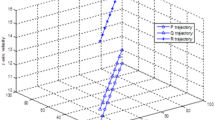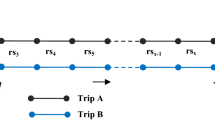Abstract
Personal route prediction has emerged as an important topic within the mobility mining domain. In this context, many proposals apply an off-line learning process before being able to run the on-line prediction algorithm. The present work introduces a novel framework that integrates the route learning and the prediction algorithm in an on-line manner. By means of a thin-client and server architecture, it also puts forward a new concept for route abstraction based on the detection of spatial regions where certain velocity features of routes frequently change. The proposal is evaluated by real-world and synthetic datasets and compared with a well-established mechanism by exhibiting quite promising results.




















Similar content being viewed by others
Notes
In the present work, we equally use the terms route or trajectory to refer to this continuous movement of a person.
References
Alvarez-Garcia J, Ortega J, Gonzalez-Abril L, Velasco F (2010) Trip destination prediction based on past GPS log using a Hidden Markov Model. Expert Syst. Appl. 37(12):8166–8171. doi:10.1016/j.eswa.2010.05.070
Barouni F, Moulin B (2012) An extended complex event processing engine to qualitatively determine spatiotemporal patterns. In: Proceedings of Global Geospatial Conference 2012, Quebec City, pp 201–2133
Carroll A, Heiser G (2010) An analysis of power consumption in a smartphone. In: Proceedings of the 2010 USENIX Conference on USENIX Annual Technical Conference, USENIX Association, Boston, MA, USENIXATC’10, pp 21–21, http://dl.acm.org/citation.cfm?id=1855840.1855861
Chen L, Lv M, Ye Q, Chen G, Woodward J (2011) A personal route prediction system based on trajectory data mining. Inf. Sci. 181(7):1264–1284, doi:10.1016/j.ins.2010.11.035
Civilis A, Jensen CS, Pakalnis S (2005) Techniques for efficient road-network-based tracking of moving objects. IEEE Trans Knowl Data Eng 17(5):698–712
Deguchi Y, Kuroda K, Shouji M, Kawabe T (2004) HEV charge/discharge control system based on navigation information. Technical report, SAE Technical Paper
de Vries G (2012) Kernel methods for vessel trajectories. PhD thesis, University of Amsterdam
Dunkel J, Bruns R, Stipkovic S (2013) Event-based smartphone sensor processing for ambient assisted living. In: 2013 IEEE Eleventh international symposium on autonomous decentralized systems (ISADS), pp 1–6. doi:10.1109/ISADS.2013.6513422
Etzion O, Niblett P (2010) Event processing in action, 1st edn. Manning Publications Co., Greenwich
Giannotti F, Nanni M, Pinelli F, Pedreschi D (2007) Trajectory pattern mining. In: Proceedings of the 13th ACM SIGKDD international conference on knowledge discovery and data mining, KDD 07. ACM, New York, pp 330–339. doi:10.1145/1281192.1281230
Guttman A (1984) R-trees: A dynamic index structure for spatial searching. In: Proceedings of the 1984 ACM SIGMOD international conference on management of data, SIGMOD ’84. ACM, New York, pp 47–57. doi:10.1145/602259.602266
He W, Li D, Zhang T, An L, Guo M, Chen G (2012) Mining regular routes from gps data for ridesharing recommendations. In: Proceedings of the ACM SIGKDD international workshop on urban computing, UrbComp ’12. ACM, New York, pp 79–86. doi:10.1145/2346496.2346510
Hendawi AM, Mokbel MF (2012) Predictive spatio-temporal queries: a comprehensive survey and future directions. In: Proceedings of the First ACM SIGSPATIAL international workshop on mobile geographic information systems, MobiGIS ’12. ACM, New York, pp 97–104. doi:10.1145/2442810.2442828
Hong K, Lillethun D, Ramachandran U, Ottenwälder B, Koldehofe B (2013) Opportunistic spatio-temporal event processing for mobile situation awareness. In: Proceedings of the 7th ACM international conference on distributed event-based systems, DEBS ’13. ACM, New York, pp 195–206. doi:10.1145/2488222.2488266
Jeung H, Shen H, Zhou X (2007) Mining trajectory patterns using Hidden Markov Models. In: Song I, Eder J, Nguyen T (eds) Data warehousing and knowledge discovery. Lecture Notes in Computer Science, vol 4654. Springer, Berlin, pp 470–480
Körner C, May M, Wrobel S (2012) Spatiotemporal modeling and analysis-introduction and overview. KI - Künstliche Intell 26(3):215–221. doi:10.1007/s13218-012-0215-2
Krumm J (2006) Real time destination prediction based on efficient routes. Technival Report, SAE Technical Paper
Krumm J (2010) Where will they turn: predicting turn proportions at intersections. Pers. Ubiquitous Comput. 14(7):591–599. doi:10.1007/s00779-009-0248-1
Krumm J, Gruen R, Delling D (2013) From destination prediction to route prediction. J Locat Based Serv 7(2):98–120. doi:10.1080/17489725.2013.788228
Lin M, Hsu WJ (2014) Mining GPS data for mobility patterns: a survey. Pervasive Mobile Comput 12(0):1–16. doi:10.1016/j.pmcj.2013.06.005
Lin M, Hsu WJ, Lee ZQ (2012) Predictability of individuals’ mobility with high-resolution positioning data. In: Proceedings of the 2012 ACM conference on ubiquitous computing, UbiComp ’12. ACM, New York, pp 381–390. doi:10.1145/2370216.2370274
Liou SC, Huang YM (2005) Trajectory predictions in mobile networks. Int J Inf Technol 11(11):109–122
Pappalardo L, Simini F, Rinzivillo S, Pedreschi D, Giannotti F, Barabási AL (2015) Returners and explorers dichotomy in human mobility. Nat Commun 6
Pham N, Ganti R, Uddin Y, Nath S, Abdelzaher T (2010) Privacy-preserving reconstruction of multidimensional data maps in vehicular participatory sensing. In: Silva J, Krishnamachari B, Boavida F (eds) Wireless sensor networks. Lecture Notes in Computer Science, vol 5970. Springer, Berlin, pp 114–130
Qiu D, Papotti P, Blanco L (2013) Future locations prediction with uncertain data. In: Blockeel H, Kersting K, Nijssen S, Železnỳ F (eds) Machine learning and knowledge discovery in databases. Lecture Notes in Computer Science, vol 8188. Springer, Berlin, pp 417–432
Song C, Qu Z, Blumm N, Barabási AL (2010) Limits of predictability in human mobility. Science 327(5968):1018–1021
Steinfeld A, Manes D, Green P, Hunter D (1996) Destination entry and retrieval with the ali-scout navigation system. Technical Report UMTRI-96-30. University of Michigan, Transportation Research Institute (UMTRI)
Stipkovic S, Bruns R, Dunkel J (2013) Pervasive computing by mobile complex event processing. In: 2013 IEEE 10th international conference on e-business engineering (ICEBE), pp 318–323. doi:10.1109/ICEBE.2013.49
Terroso-Saenz F, Valdes-Vela M, Campuzano F, Botia JA, Skarmeta-Gómez AF (2015) A complex event processing approach to perceive the vehicular context. Inf Fusion 21(0):187–209. doi:10.1016/j.inffus.2012.08.008
Wang L, Hu K, Ku T, Yan X (2013) Mining frequent trajectory pattern based on vague space partition. Knowl Based Syst 50(0):100–111, doi:10.1016/j.knosys.2013.06.002
Xue A, Zhang R, Zheng Y, Xie X, Huang J, Xu Z (2013) Destination prediction by sub-trajectory synthesis and privacy protection against such prediction. In: 2013 IEEE 29th international conference on data engineering (ICDE), pp 254–265. doi:10.1109/ICDE.2013.6544830
Zhang J, Goodchild MF (2002) Uncertainty in geographical information. Taylor & Francis, London
Zheng Y, Xie X, Ma WY (2010) Geolife: a collaborative social networking service among user, location and trajectory. IEEE Data Eng Bull 33(2):32–39
Zhou C, Frankowski D, Ludford P, Shekhar S, Terveen L (2004) Discovering personal gazetteers: an interactive clustering approach. In: Proceedings of the 12th annual ACM international workshop on Geographic information systems. ACM, pp 266–273
Zhou J, Tung AK, Wu W, Ng WS (2013) A “semi-lazy” approach to probabilistic path prediction in dynamic environments. In: Proceedings of the 19th ACM SIGKDD international conference on knowledge discovery and data mining, KDD ’13. ACM, New York, pp 748–756. doi:10.1145/2487575.2487609
Ziebart BD, Maas AL, Dey AK, Bagnell JA (2008) Navigate like a cabbie: Probabilistic reasoning from observed context-aware behavior. In: Proceedings of the 10th international conference on ubiquitous computing, UbiComp ’08. ACM, New York, pp 322–331. doi:10.1145/1409635.1409678
Acknowledgments
This research is partially funded by the Spanish Ministry of Economy and Competitiveness’ project “Dynamic and Emergent intelligent for Smart Cities based on Internet of Things” TIN2014-52099-R and the European Commission through the ENTROPY-649849 EU Project.
Author information
Authors and Affiliations
Corresponding author
Additional information
Responsible editor: Pierre Baldi.
Appendices
Appendix 1: Event-based rules
Broadly speaking, event-processing rules usually comprises two different parts, (1) a condition part where the requirements for the rule to fire are listed and (2) an action part that indicates the actions to be done if the condition part is fulfilled. Hereafter, the rules pseudocode included in PRoPTurn are listed.

where the -> stands for the followed-by operator.

where [1:n] stands for a range between 1 and n events.

where .within defines the time window with no filtered GPS events for the rule to fire.
Appendix 2: Geolife Users’ profiles
# user | Total | Per route | |||
|---|---|---|---|---|---|
Locations | Routes | Time period | Locations | Time length | |
1 | 867,170 | 2111 | 2007-07-21 \(\rightarrow \) 2012-06-17 | 408 | 22\('\) |
2 | 205,168 | 982 | 2008-10-23 \(\rightarrow \) 2009-07-29 | 208 | 19\('\) |
3 | 280,256 | 838 | 2007-04-12 \(\rightarrow \) 2012-07-27 | 334 | 26\('\) |
4 | 180,324 | 691 | 2008-10-23 \(\rightarrow \) 2009-07-05 | 260 | 26\('\) |
5 | 343,401 | 559 | 2008-09-14 \(\rightarrow \) 2009-09-13 | 614 | 26\('\) |
6 | 240,135 | 523 | 2008-03-01 \(\rightarrow \) 2009-02-17 | 459 | 25\('\) |
7 | 175,850 | 496 | 2009-01-13 \( \rightarrow \) 2009-07-29 | 354 | 22\('\) |
8 | 261,627 | 450 | 2008-12-15 \( \rightarrow \) 2009-07-11 | 581 | 33\('\) |
9 | 280,076 | 443 | 2008-10-30 \( \rightarrow \) 2009-07-04 | 632 | 32\('\) |
10 | 116,404 | 392 | 2008-04-28 \( \rightarrow \) 2009-09-24 | 296 | 23\('\) |
11 | 123,604 | 390 | 2007-04-18 \( \rightarrow \) 2011-03-10 | 316 | 30\('\) |
12 | 180,034 | 387 | 2007-12-07 \( \rightarrow \) 2008-12-15 | 465 | 34\('\) |
13 | 74,978 | 357 | 2008-10-23 \( \rightarrow \) 2009-07-05 | 210 | 21\('\) |
14 | 168,990 | 324 | 2008-02-13 \( \rightarrow \) 2009-09-28 | 521 | 35\('\) |
15 | 147,514 | 321 | 2008-10-20 \( \rightarrow \) 2009-04-17 | 459 | 20\('\) |
16 | 157,084 | 317 | 2008-04-02 \( \rightarrow \) 2009-02-22 | 495 | 28\('\) |
17 | 125,441 | 312 | 2007-04-28 \( \rightarrow \) 2009-09-28 | 402 | 20\('\) |
18 | 138,703 | 254 | 2008-07-21 \( \rightarrow \) 2009-09-11 | 546 | 40\('\) |
19 | 120,110 | 247 | 2008-10-23 \( \rightarrow \) 2009-03-22 | 486 | 36\('\) |
20 | 72,677 | 227 | 2009-02-11 \( \rightarrow \) 2009-07-12 | 320 | 31’\('\) |
Total | 4259,546 | 10,606 | 2007-04-12 \(\rightarrow \) 2012-07-27 | 418 | 27\('\) |
Rights and permissions
About this article
Cite this article
Terroso-Saenz, F., Valdes-Vela, M. & Skarmeta-Gomez, A.F. Online route prediction based on clustering of meaningful velocity-change areas. Data Min Knowl Disc 30, 1480–1519 (2016). https://doi.org/10.1007/s10618-016-0452-3
Received:
Accepted:
Published:
Issue Date:
DOI: https://doi.org/10.1007/s10618-016-0452-3




